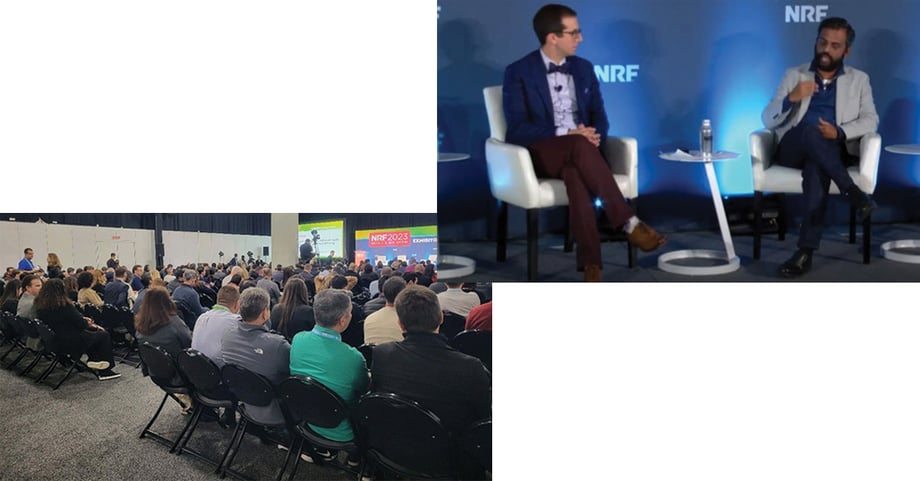
Among the highlights of our most recent retail trade event appearances—NRF in New York and RILA LINK in Orlando—were our well-received feature presentations, spotlighting one of our major success stories among national retailers, our partnership with Walgreens.
At both sessions, I had the pleasure of sitting down with Andy Kettlewell, Walgreens Group VP of Inventory & Analytics, to look back on Walgreens’ successful AI transformation—leveraging a wealth of advanced data sets to better achieve their core mission—meeting the health & wellness needs of 9 million daily customers across 9,000 store locations nationwide, plus sizeable omnichannel sales.

Our featured co-presentation at NRF
As early as 2017—long before a pandemic abruptly redefined much of our daily world—Walgreens began reimagining demand planning and forecasting to better serve an already changing customer. Up through the 2010s, Walgreens’ outbound marketing primarily consisted of a weekly print advertising supplement, included in Sunday newspapers and available to shoppers after they’d already entered a store. Short-term demand for specific food, drug or personal care/beauty products could be broadly influenced by attractive sale prices on the front page of the insert.
Of course, printed newspapers continue to all but disappear—and Walgreens no longer prints a weekly ad at all. In its place, Walgreens looked to embrace next-generation demand planning tools, harnessing leading-edge AI technology and predictive data science to dramatically enhance demand planning, inventory allocation, and overall customer satisfaction versus competitors.
The initial step was changing how Walgreens talked to the customer, drawing upon their existing loyalty card program—over 100 million members strong, with growing numbers also connecting via the Walgreens mobile app. Beyond rewarding customers after a purchase, how could that huge audience—driven by an entirely different set of stimuli—be better engaged to shape future demand, and distribute inventory accordingly?
The answer revolved around proactively reaching out to customers on a personal level, utilizing voluminous sets of localized, granular-level data, not only internal sales goals, but attuning demand around customers’ daily lives—outside of Walgreens—spanning seasonal, monthly, or even hourly time frames, such as:
- Current local weather forecasts influencing demand for over-the-counter cold/allergy medications—or bottled drinks and sunscreen.
- A popular social media influencer endorsing a brand of cosmetics.
- The closure of a large factory or other major local event impacting shoppers’ priorities.
- A sports game or concert at a local arena—anticipating what items might be convenient for pickup at the nearest Walgreens before or after the event.
Prior to the advent of AI, demand planning around a single SKU might have been as simple as pulling in three internal/external variables. Today, it could potentially take into account 50 or more—a monumental task for any human analyst to sift through at Walgreens’ scale: a 300 million time series forecast among those 9,000 locations. AI has proved instrumental for simplifying intricate data sources into effective, low-touch demand forecasts and inventory planning throughout every store.
Our AI solutions have enabled Walgreens to reaffirm their core positioning—as a provider of customer solutions, from being their go-to resource for vaccinations and expanded ancillary health services, to providing parents that coveted bottle of medicine for their sick child at all hours of day and night, to helping them navigate the recent troubling shortage of baby formula—and other supply chain volatility that will likely continue to plague us for some time. Our AI-powered tools enable Walgreens to better anticipate every detail—the brands, sizes, and flavors shoppers expect—as well as predicting the best times to stock extra units on a shelf.
I was also curious to get Andy’s advice for other retailers looking to embark upon their own AI journey. He recalled how, after defining their own forecasting and allocation vision, collaborating with antuit.ai on a live test-and-learn pilot—a relatively small sample size of 10-15 million item/store combinations—was key to validating hypotheses and achieving positive results before a methodical, year-long rollout. Despite some early trepidation around adopting a “black box” for internal decision-making, he affirmed that AI technologies, and the vast dimensions of actionable data they utilize, are ready to take center stage for any large retailer looking to keep pace with a changing customer.
Shortly before our first presentation at NRF, we were pleased to learn Andy’s leadership of Walgreens’ AI-powered demand planning initiative was formally recognized by Retail TouchPoints, which included him among this year’s select winners of their annual Retail Innovator Awards. In the ever-competitive retail world, we view our customers’ successes as the ultimate benchmark of our success.
I invite you to view the full recording of our NRF presentation and other useful video content here. And for more information about our demand planning, allocation and other AI-powered solutions for retailers and CPGs, contact us.

